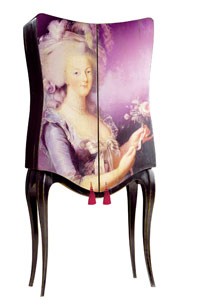Sign up to receive the latest news from Sweetpea & Willow, including new arrivals, exclusive discounts and more.
* Full priced products only. Excludes certain brands. T&C apply.

The reign of the French king Louis XIV was characterised by the Baroque style. The Versailles Palace and the Louvre were decorated in a strong, dramatic and exuberant style echoing the king’s strong leadership in a period of war and colonial empire building. The French classical Baroque style was grand and impressive, a symbol of power.
France’s next king, Louis XV and his mistress, Madame de Pompadour embraced the Rococo style: frivolous and frothy, fairytale scenes of nymphs and cherubs painted and carved onto furniture and mirrors. Decadent chaise longue and exuberantly carved beds, often covered in gilt, added elegance and sparkle to homes of the Parisian aristocracy.
Such excesses and hedonism led to public dissatisfaction and discontent, culminating in the French Revolution, the overthrow of the corrupt and indulgent monarchy. With the rise to power of Napoleon Bonaparte came the growth of Neo-Classicism, a return to a classical style echoing the designs of the Roman Empire, symbolizing strength, order and authority. A sense of gravitas was expressed through furniture and design that was intended to expunge the memories of the frivolous Rococo style.
In England in the early eighteenth century, the Georgian style replaced the melodrama of the Baroque, it marked a move towards elegance and proportion. Buildings and furniture were refined and symmetrical, with details borrowed from Classical Greek and Roman architecture.
In Scandinavia in the eighteenth century there was a rather more subdued approach to architecture and furniture design. Swedish Gustavian furniture displays simple classical elegance, painted in white or muted tones such as blues, greens or Nordic grey. This style of furniture displays calmness and serenity, a celebration of rustic charm and simplicity.
The nineteenth century in England was the Victorian era, represented by heavily ornamented carved mahogany or oak furniture with brass details. Upholstered armchairs and sofas in ornate and sumptuous fabrics or masculine leather filled the rooms of Victorian homes. The Victorians favoured formal dining rooms and mahogany display cabinets to showcase their books and prized possessions.
Moving into the twentieth century you saw the birth of Art Nouveau, a complex and artistic style inspired by nature. Architecture, furniture, jewellery, lighting and glassware were decorated with images of ethereally beautiful women and serpentine naturalistic forms.
The Art Deco style of the 1920s and 1930s moved design into the modern era, the machine age. It embrace speed, new technologies, graphic shapes and clean lines, the elegance of the ocean liner. Crystal chandeliers, chrome lamps and mirrored dressing tables created a sense of glamour and elegance.
As the twentieth century progressed, contemporary furniture design became more eclectic and challenging. Designers such as Le Corbusier, Mies van der Rohe and Eames used chrome, leather and plywood to create chairs and other furniture whose simple and striking beauty has made them design classics. Lighting also employed reflective chrome and striking geometrical shapes.
Whatever your historical preference, Sweetpea and Willow has something to suit you.